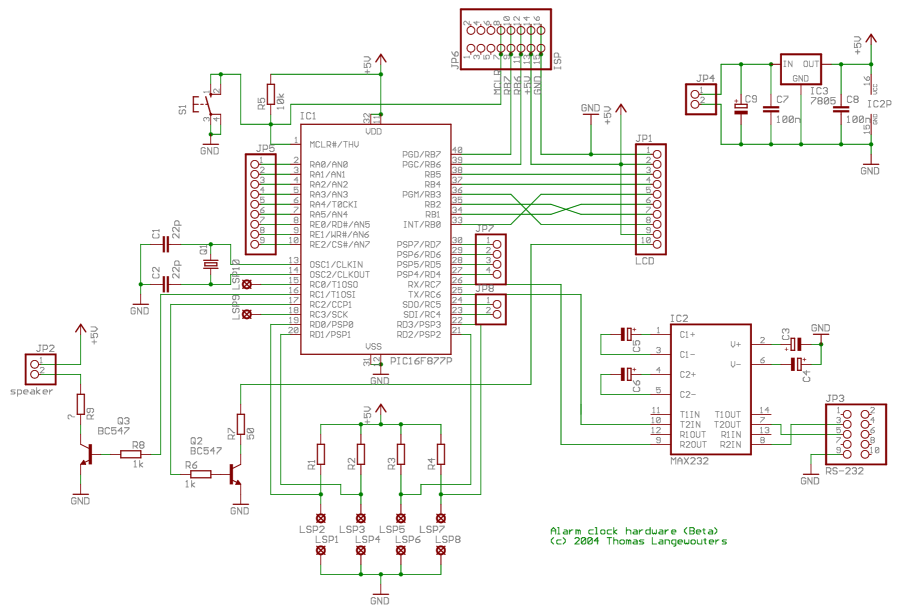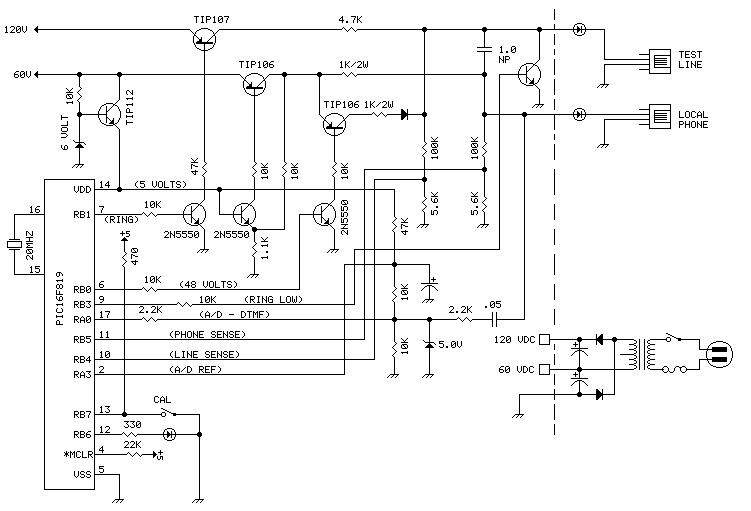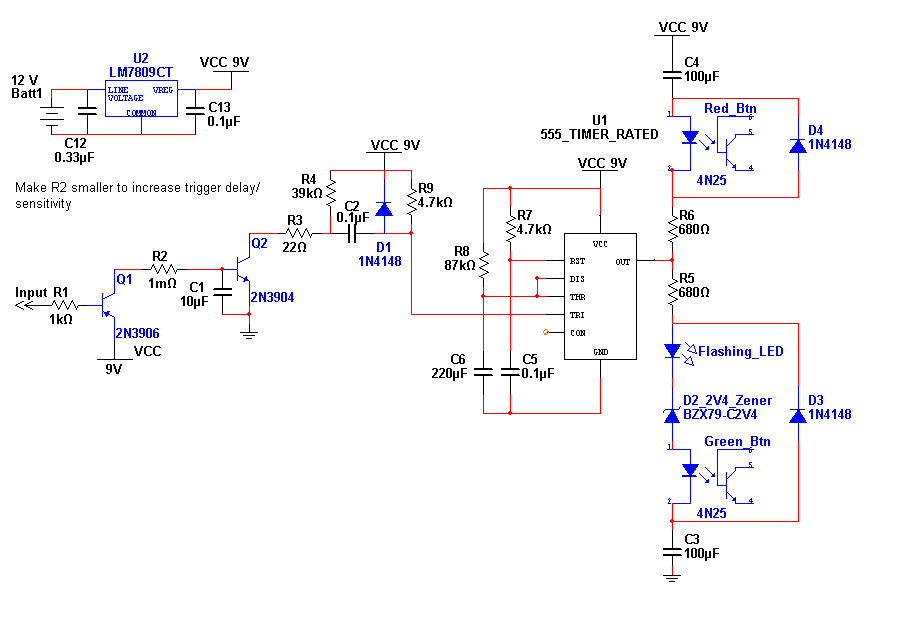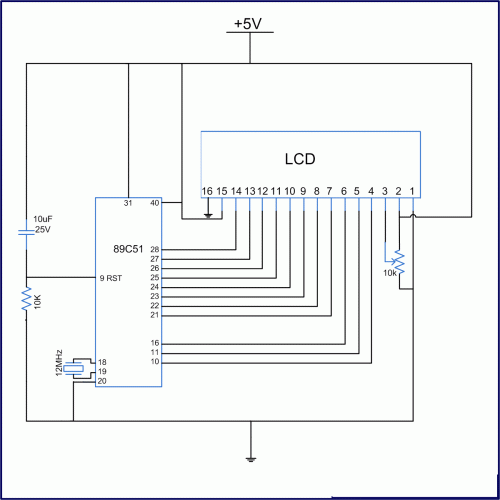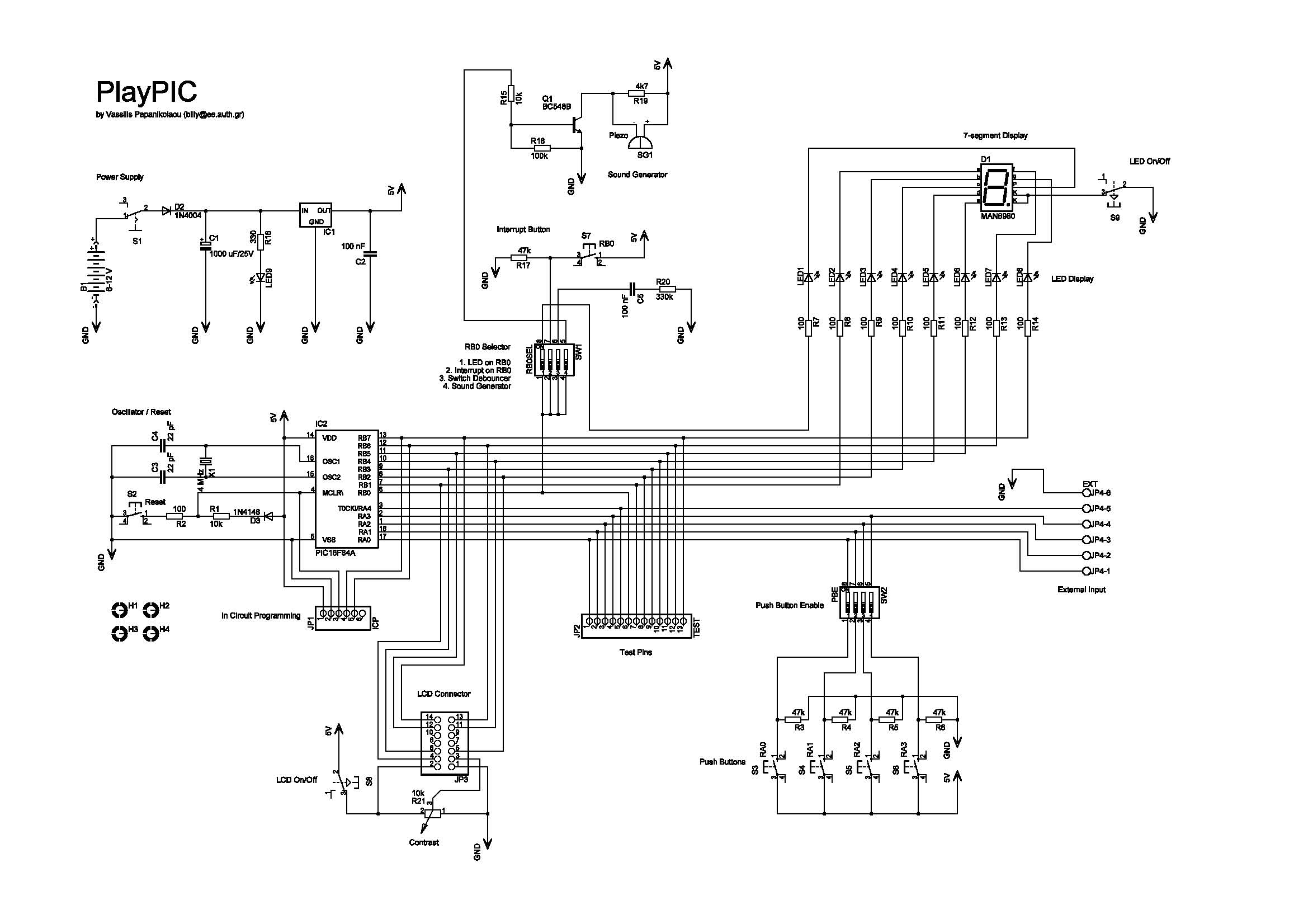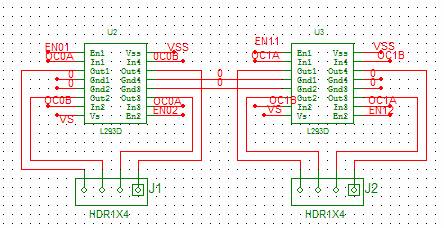
pic digital clock timer
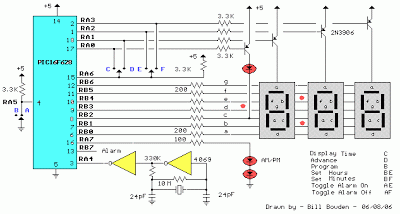
The clock timer utilizes a PIC16F628 microcontroller to display time in a 3.5-digit format and manage an external load. It features a calendar that accounts for leap years and optional daylight saving time adjustments. The timer output can be configured for durations ranging from 1 to 59 minutes and can be manually toggled on and off. Additionally, the clock incorporates a correction function that allows for the addition of an extra second after a specified number of hours to compensate for a slightly slow oscillator. The oscillator operates with a standard 32.768 kHz watch crystal, with frequency adjustments possible through a 24pF capacitor positioned adjacent to the crystal. There are seven displays that progress each time the 'D' switch is activated. For adjustments, the RA5 switch should be set to the "B" position, followed by toggling the E and F switches to navigate through the hours or minutes digits. The 'D' switch is used to advance to the next data point. After reaching the seventh display, the system cycles back to the current time. Alternatively, pressing the time switch 'C' will return to the top display at any moment. Once all settings are complete, the RA5 switch should be returned to the "A" position to prevent accidental changes. The current settings can still be viewed using the 'D' advance key, while the E and F switches will only activate or deactivate the alarm at RB7. This system can be paired with an external transistor to control a radio. The daylight saving time setting, found in the sixth display within the minutes digits, facilitates adjustments for daylight saving time—advancing one hour on the second Sunday in March and reverting one hour on the first Sunday in November. The entry options for this setting are 0, 1, or 3. The last two entries correspond to the current year (1 to 4), with 4 indicating a leap year; for instance, the setting for 2006 would be 2, as the next leap year will be in 2008. The correction setting allows for the addition of a second every specified number of hours to fine-tune the oscillator frequency, with a personal setting of 18 hours, resulting in a loss of approximately 3 seconds per month. It is advisable to operate the system for a couple of weeks to determine the necessary correction for the specific crystal utilized.
The clock timer circuit is designed around the PIC16F628 microcontroller, which handles the timekeeping and display functions. The microcontroller interfaces with a 7-segment display to visually represent the time, leveraging a multiplexing technique to drive the display efficiently. The microcontroller's GPIO pins are configured to control the display segments and manage the input from the various switches (RA5, D, E, F, and C).
The timing function relies on a 32.768 kHz crystal oscillator, which is a common choice for timekeeping applications due to its stability and availability. The addition of a 24pF capacitor allows for fine-tuning of the oscillator frequency, which is critical for maintaining accurate time. The correction feature is implemented through software adjustments in the microcontroller, which periodically adds an extra second based on the user-defined settings.
The user interface is designed for ease of use, with the RA5 switch determining the operational mode (A for normal operation and B for setting adjustments). The toggling of the E and F switches allows users to increment or decrement the time settings, while the D switch advances through the configuration menus. The inclusion of an alarm feature, activated via the RB7 pin, permits the control of external devices such as radios, enhancing the functionality of the clock timer.
The calendar function is robust, accounting for leap years and daylight saving time adjustments, which are programmed into the microcontroller's logic. Users can input their specific settings for daylight saving time, ensuring that the clock remains accurate throughout the year. Overall, this clock timer circuit represents a versatile and customizable solution for timekeeping and load control applications.Clock timer uses a PIC16F628 microcontroller to display 3 and 1/2 digit time and control an external load. The clock includes a calendar with leap year and optional daylight savings adjustments. The timer output can be set from 1 to 59 minutes and manually switched on and off. The clock also has a correction feature that allows an additional second to be added every so many hours to compensate for a slightly slow running oscillator. The oscillator uses a common 32. 768 KHz watch crystal and the frequency can be adjusted slightly with the 24pF capacitor on the right side of the crystal. There are 7 displays that advance each time the `D` switch is toggled. To make adjustments, set the RA5 switch to the "B" position and then toggle the E and F switches to advance the data in the hours or minutes digits.
Then toggle the "D" switch to move to the next data. After the 7th display, it will go back to the top and display the current time. Or, just press the time switch `C` to get to the top at anytime. When done setting everything up, set the RA5 switch to the "A" position so the data cannot be accendentally changed. You can still view everything with the "D" advance key, but the E an F switches will just turn on or off the alarm at RB7.
I use it with an external transistor to switch on and off a radio. The `Daylight savings` setting (in the 6th display in the minutes digits) is used to enable daylight savings time adjustments, one hour ahead on the 2nd sunday in March, and one hour behind on the first sunday in November. The entry will be either 0, 1, or 3. The last 2 entries on the list (Year and Correction) is for the current year (1 to 4) (4 = Leapyear) so today`s setting (2006) will be 2 since leapyear will be on year 4 which is 2 years from now.
The correction setting will add a second every so many hours for fine adjustment to the oscillator frequency. My setting is 18 which adds a second every 18 hours. It`s pretty accurate and only loses 3 seconds a month. You probably want to run it for a couple weeks to figure out what correction is needed for the crystal you have.
🔗 External reference
The clock timer circuit is designed around the PIC16F628 microcontroller, which handles the timekeeping and display functions. The microcontroller interfaces with a 7-segment display to visually represent the time, leveraging a multiplexing technique to drive the display efficiently. The microcontroller's GPIO pins are configured to control the display segments and manage the input from the various switches (RA5, D, E, F, and C).
The timing function relies on a 32.768 kHz crystal oscillator, which is a common choice for timekeeping applications due to its stability and availability. The addition of a 24pF capacitor allows for fine-tuning of the oscillator frequency, which is critical for maintaining accurate time. The correction feature is implemented through software adjustments in the microcontroller, which periodically adds an extra second based on the user-defined settings.
The user interface is designed for ease of use, with the RA5 switch determining the operational mode (A for normal operation and B for setting adjustments). The toggling of the E and F switches allows users to increment or decrement the time settings, while the D switch advances through the configuration menus. The inclusion of an alarm feature, activated via the RB7 pin, permits the control of external devices such as radios, enhancing the functionality of the clock timer.
The calendar function is robust, accounting for leap years and daylight saving time adjustments, which are programmed into the microcontroller's logic. Users can input their specific settings for daylight saving time, ensuring that the clock remains accurate throughout the year. Overall, this clock timer circuit represents a versatile and customizable solution for timekeeping and load control applications.Clock timer uses a PIC16F628 microcontroller to display 3 and 1/2 digit time and control an external load. The clock includes a calendar with leap year and optional daylight savings adjustments. The timer output can be set from 1 to 59 minutes and manually switched on and off. The clock also has a correction feature that allows an additional second to be added every so many hours to compensate for a slightly slow running oscillator. The oscillator uses a common 32. 768 KHz watch crystal and the frequency can be adjusted slightly with the 24pF capacitor on the right side of the crystal. There are 7 displays that advance each time the `D` switch is toggled. To make adjustments, set the RA5 switch to the "B" position and then toggle the E and F switches to advance the data in the hours or minutes digits.
Then toggle the "D" switch to move to the next data. After the 7th display, it will go back to the top and display the current time. Or, just press the time switch `C` to get to the top at anytime. When done setting everything up, set the RA5 switch to the "A" position so the data cannot be accendentally changed. You can still view everything with the "D" advance key, but the E an F switches will just turn on or off the alarm at RB7.
I use it with an external transistor to switch on and off a radio. The `Daylight savings` setting (in the 6th display in the minutes digits) is used to enable daylight savings time adjustments, one hour ahead on the 2nd sunday in March, and one hour behind on the first sunday in November. The entry will be either 0, 1, or 3. The last 2 entries on the list (Year and Correction) is for the current year (1 to 4) (4 = Leapyear) so today`s setting (2006) will be 2 since leapyear will be on year 4 which is 2 years from now.
The correction setting will add a second every so many hours for fine adjustment to the oscillator frequency. My setting is 18 which adds a second every 18 hours. It`s pretty accurate and only loses 3 seconds a month. You probably want to run it for a couple weeks to figure out what correction is needed for the crystal you have.
🔗 External reference
Warning: include(partials/cookie-banner.php): Failed to open stream: Permission denied in /var/www/html/nextgr/view-circuit.php on line 713
Warning: include(): Failed opening 'partials/cookie-banner.php' for inclusion (include_path='.:/usr/share/php') in /var/www/html/nextgr/view-circuit.php on line 713
